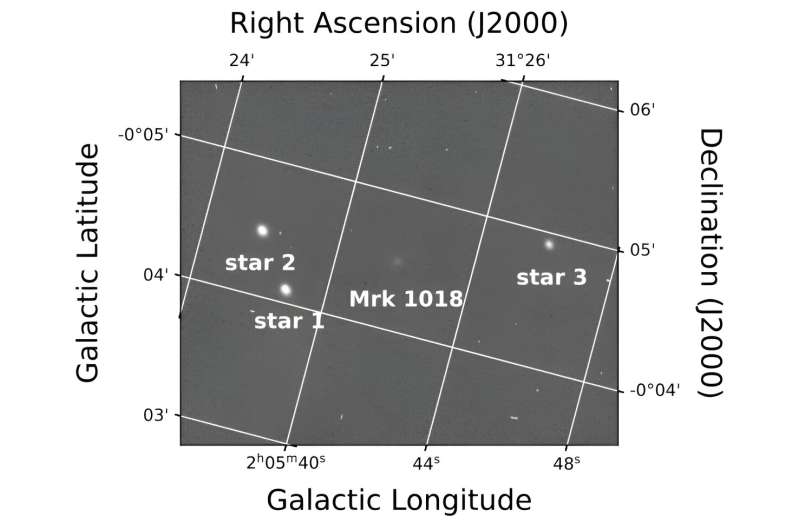August 3, 2023 report
This article has been reviewed according to Science X's editorial process and policies. Editors have highlighted the following attributes while ensuring the content's credibility:
fact-checked
preprint
trusted source
proofread
Study investigates recent outburst in the active galaxy Markarian 1018

An international team of astronomers has performed high-cadence optical monitoring of an active galaxy known as Markarian 1018. Results of the observational campaign, published July 26 on the pre-print server arXiv, shed more light on the nature of the recent outburst in this galaxy.
An active galactic nucleus (AGN) is a compact region at the center of a galaxy, more luminous than the surrounding galaxy light. AGNs are very energetic due either to the presence of a black hole or star formation activity at the core of the galaxy.
Astronomers generally divide AGNs into two groups based on emission line features. Type 1 AGNs show broad and narrow emission lines, while only narrow emission lines are present in Type 2 AGNs. However, observations revealed that some AGNs transition between different spectral types and they are known as changing-look (CL) AGNs.
At a redshift of 0.043, Markarian 1018 (or Mrk 1018 for short) is an active galaxy and AGN system. It is a post-merger remnant—the host galaxy is clearly irregular, with a tidal tail. Previous observations of Mrk 1018 have found that its AGN belongs to a group of extremely rare CL-AGNs with multiple transitions.
A group of astronomers led by Roisín Brogan of University of Potsdam in Germany commenced in October 2019 a high-cadence optical monitoring of the AGN in Mrk 1018. The observations, conducted with STELLA telescopes at the Izana Observatory in Tenerife, Spain, caught an impressive outburst in mid-2020.
The observational campaign found that the 2020 outburst was asymmetric with a rise of less than 100 days and a decline of at least 200 days. The astronomers noted that the best-fit function to the decline is linear, thus this suggests that the outburst was not caused by a tidal disruption event (TDE) as these flares are expected to decline with a power-law shape.
Moreover, the team analyzed X-ray and ultraviolet XMM-Newton observations taken approximately 18 months before and seven months after the observed optical peak of the outburst. No intrinsic absorption was found before and after the outburst, which rules out the scenario that the observed increase of emission was due to a temporary decrease in obscuring material.
All in all, the results suggest that the outburst most likely caused by a drastic, short-term increase of the accretion rate, for which there are multiple explanations.
"We discuss several scenarios. Disk models are likely too inefficient to drive the observed rapid increase and decrease in the AGN's light curves. CCA [chaotic cold accretion] can explain the observed short-term outburst with a few orders of magnitude change in rapid time. Other potential interpretations can be ascribed to a BBH [binary black hole] or a rSMBH [recoiling supermassive black hole]," the authors of the paper concluded.
More information: R. Brogan et al, Still alive and kicking: A significant outburst in changing-look AGN Mrk 1018, arXiv (2023). DOI: 10.48550/arxiv.2307.14139
Journal information: arXiv
© 2023 Science X Network





















